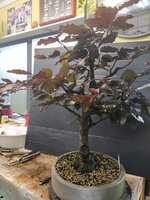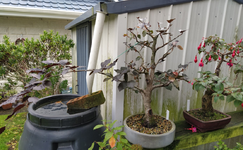fredman
Masterpiece
I'm busy growing out to thicken the lowest branch on a European beech....it's about a meter long at this stage, and needs to do some more growing to thicken. I also want to start doing hedge cutting to ramify on the rest of the tree. I actually want to cut back to the second node.
Being such a slow grower, the tree might be set back because of the growing out taking most of the vigor from the tree....?
The leaves has hardened off and the timing is right to do the hedge now...but i'm unsure if it's wise to do both together.
Any ideas plz...
Also...what is the best way to thicken a branch? Is it best to leave all side branches on it, or remove it so the branch extends quicker?
Being such a slow grower, the tree might be set back because of the growing out taking most of the vigor from the tree....?
The leaves has hardened off and the timing is right to do the hedge now...but i'm unsure if it's wise to do both together.
Any ideas plz...
Also...what is the best way to thicken a branch? Is it best to leave all side branches on it, or remove it so the branch extends quicker?
Last edited:






